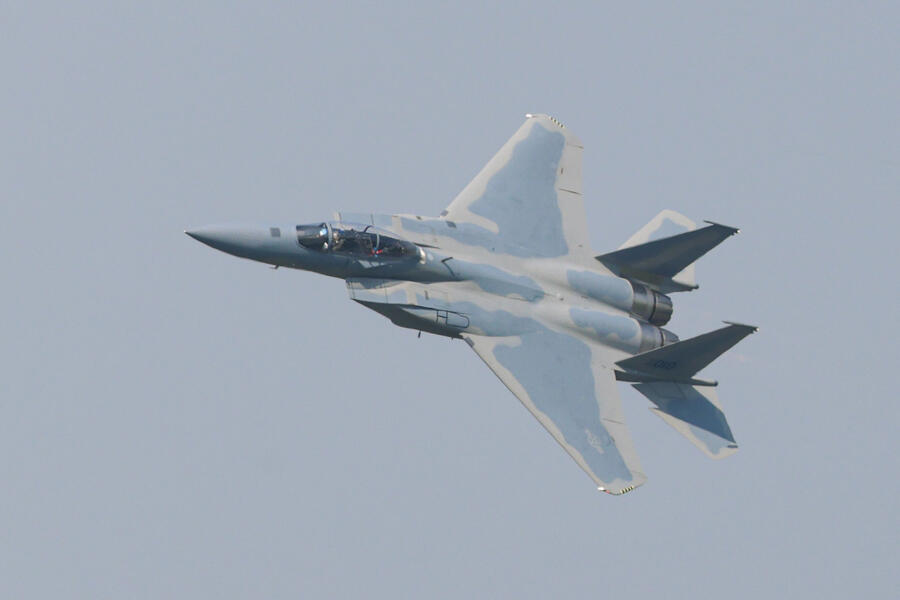AlphaMosaic: AI-Powered Battle Management Takes Flight
Three Points to Remember
- Military operators need to make important decisions rapidly during combat but can struggle to process information fast enough.
- AlphaMosaic, developed by Leidos, enables AI agents to provide operators with decision support in combat scenarios involving multiple aircraft, weapons systems and targets.
- AlphaMosaic has successfully supported battle exercises, and there’s potential that the AI technology can be scaled to address decision-making for warfighters in a variety of roles.
Flying high at 30,000 feet, a weapon systems officer (WSO) in the back seat of an F-15EX fighter jet faces a cascade of critical decisions during an air battle. The enemy has superior numbers, and multiple targets demand attention. Fuel reserves need constant monitoring. Coordination with a dozen other aircraft requires split-second timing. But instead of juggling paper charts and mental calculations, the WSO taps a tablet displaying real-time, AI-generated options. Risk levels for each course of action appear in clear visual formats. Weapon-and-target pairings optimize themselves based on mission priorities. What once took 20 to 30 minutes now happens in seconds in a situation where decision advantage and time are critical.
This scene played out in an early 2025 exercise at Eglin Air Force Base and represented years of artificial intelligence development experience that was compressed into a 90-day sprint from concept to cockpit. The technology enabling this transformation into the rapidly deployable solution — AlphaMosaic, developed by Leidos — emerged from the Defense Advanced Research Projects Agency's (DARPA) Air Combat Evolution (ACE) program as a flexible framework enabling AI agents to provide decision support to warfighters.
“We’ve gone from sim to reality and burned down significant risks towards fielding,” says Tim Keeter, collaborative autonomy lead and master solution architect at Leidos. “Understanding and collaborating with these agents mirrors the way humans have always done this with each other.”
AlphaMosaic exemplifies how Leidos leverages innovative autonomous solutions and mission software to protect our national security. With further development, there’s potential that the AI technology in AlphaMosaic can be scaled to address decision-making for warfighters in a variety of roles.
The complexity challenge
Modern warfare presents military operators with decision-making burdens that can quickly become overwhelming. As conflicts grow more complex, with multiple aircraft, weapons systems and rapidly changing scenarios, human operators will undoubtedly struggle to process information fast enough to maintain tactical advantage. The U.S. military knows this, and it is prioritizing efforts to find solutions. And Leidos understands the urgency in solving this challenge, as it’s critical for the success of our nation’s warfighters.
“The battle hits you all at once and you’ve got to make 30 to 40 minutes' worth of decisions in 30 seconds if you want to maintain decision superiority,” explains Kevin Albarado, lead autonomy architect and program manager for AlphaMosaic. “You can’t preempt any of it. There are just too many decision pathways there.”
Consider a related challenge: aerial refueling. It's another process that demands intensive human coordination. Mission planners must determine who needs fuel, when they need it and how to maintain combat readiness throughout the operation. One disabled tanker can cascade into mission failure without rapid replanning.
“It’s a pretty high cognitive burden, requiring teams of people, to come up with one of these fuel schedules quickly,” Albarado says. That’s where AlphaMosaic-developed AI agents come in. “But it’s a pretty low burden to look at a schedule optimized and proposed by our software and go, ‘That one works,’” Albarado explains. “So we’re just providing the one that works, and we’re doing it while also helping with a lot of other decisions that battle managers have to make.”
A different kind of AI
In contrast to one monolithic AI system, AlphaMosaic employs a network of specialized AI agents that mirror how military teams already operate. Each agent handles specific decisions — fuel scheduling, weapon assignment, flight positioning — while communicating within a larger ecosystem.
“We’re essentially building a virtual, augmenting workforce,” says Will Mahoney, vice president and CTO of airborne systems at Leidos. “And they work together under the supervision of the human operators to achieve these things.”
This disaggregated approach offers critical advantages. Individual agents can be updated without overhauling the entire system. Human operators can intervene at any level, from tactical details to strategic planning. Most importantly, the system presents complexity to adversaries while simplifying decisions for friendly forces.
Although trained on sophisticated server arrays, the framework deploys as lightweight microservices rather than requiring large computing infrastructures to operate. That means AlphaMosaic agents run on standard tablets and regular CPUs — even years-old legacy hardware.

We're essentially building a virtual, augmenting workforce. And they work together under the supervision of the human operators.
Will Mahoney
VP, Airborne Systems CTO, on AlphaMosaic-developed AI agents
From laboratory to cockpit
The Blue Horizons Fellowship program at Maxwell Air Force Base provided AlphaMosaic’s most dramatic real-world validation. A team of three officers challenged the Leidos team to solve the persistent problem of matching weapons to targets across complex battlespaces.
Working with the AlphaMosaic framework, the team created Jarvis (named after the Marvel Comics AI assistant) in just 90 days. The application transformed battle planning from a 20- to 30-minute manual exercise into a 15-second digital process.
During testing at Emerald Flag exercises, WSOs using tablet-based Jarvis were able to evaluate three risk-based options simultaneously: prioritizing aircraft survivability, maximizing speed to target and accepting higher risk for maximum lethality.
“It gives them a menu of options to choose from versus the weapon systems officer having to go through that calculation and think through it from scratch,” Mahoney explains. One WSO even requested additional targets, finding that the AI assistance freed up cognitive capacity for more complex tactical thinking.
It’s one thing to present these solutions so quickly but another for the operators to trust the solutions. Repeatedly, highly experienced WSOs admitted that had they had more time to develop the solutions, they would have made the same decisions recommended to them by Jarvis.
The total investment was a fraction of traditional defense development costs (under $1 million), made possible thanks to integration with existing data and hardware. “We don’t deliver things to the warfighter that they don’t already know how to use; that wouldn’t make sense to them,” Keeter says. “We work with the data they already have. We work with the systems they already have. And we are elastic enough to incorporate new technology as the customer adds it.”
Expanding the mission envelope
AlphaMosaic’s next deployments will likely focus on aerial refueling through an ongoing research and development campaign. The AI agents have demonstrated the ability to quickly recalculate fuel schedules in response to equipment failures or changing combat situations, maintaining fuel schedules that keep all aircraft mission-capable.
One surprising capability emerged during the DARPA ACE program.
AlphaMosaic agents began calling aircraft for refueling after using only 20% of an aircraft’s fuel — seemingly premature until analysis revealed the AI was positioning aircraft for critical engagements many moves ahead, like a chess master preparing for an endgame.
The framework’s flexibility has the potential to enable applications across the entire spectrum of combat. At the pilot level, agents could assist with immediate tactical decisions. Air operations centers could use AlphaMosaic for broader battle management. Mission planners could evaluate different scenarios before aircraft launch. Operational analysis teams could model how new platforms and weapons systems might perform in future conflicts.
“We’re pressing hard on this, and it’s important to us,” Keeter says. “It’s not just important to us as a company. It’s important to us as patriots.”




